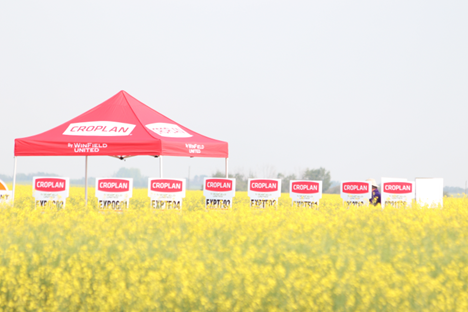WinField® United Canada’s Answer Plot® serves as a comprehensive platform to deliver insights, address variability, and enhance predictability. The site is utilized for tours and to showcase the outcomes of side-by-side replicated trials featuring products from trusted partners’ products and WinField United Canada solutions. Each year, Answer Plot provides attendees with a hands-on learning experience with demonstrations and trials across various crops.
This year, WinField United welcomed over 250 visitors for plot tours at Answer Plot, showcasing the knowledge gained in the field. Martin Carr, Agronomy Manager for Western Canada with WinField United Canada, shared highlights from the 2024 Answer Plot site, including insights on trials covering wild oat management, canola performance, water quality, and WinField United adjuvants.
Wild Oat Management Demo
Wild oat is a challenging weed for farmers in Western Canada. Although its densities and frequency have decreased since the 1970s, wild oat remains one of the top ten weeds on the Prairies1. The reduced control of this troublesome weed is often related to its resistance to Group 1 chemistries, and the Wild Oat Management demo at Answer Plot highlighted alternative options to support its management throughout the rotation.
“As part of this demonstration, we wanted to draw attention to the non-Group 1 options for managing wild oats,” Carr explains. “This years’ optimal growing conditions resulted in excellent wild oat emergence, and we found that even non-resistant wild oats were challenging to kill.”
“As part of this demonstration, we wanted to draw attention to the non-Group 1 options for managing wild oats,” Carr explains. “This years’ optimal growing conditions resulted in excellent wild oat emergence, and we found that even non-resistant wild oats were challenging to kill.”
“The days of just spraying once and killing 99.7% of pests are probably over, so what can we do to help manage it?” says Carr. “Integrated Pest Management (IPM) strategies play a key part in slowing the development of herbicide resistance. Including PRE herbicides with a residual effect as part of an IPM approach can be particularly effective.”
Carr explains that the trial demonstrated different methods for controlling wild oats, highlighting various modes of action. He notes that the effects of some herbicides, especially PREs, aren’t always immediately visible. The goal was to clearly show how each mode of action works and emphasize the importance of using a variety of methods throughout the crop rotation instead of relying solely on Group 1 herbicides.
Carr explains that the trial demonstrated different methods for controlling wild oats, highlighting various modes of action. He notes that the effects of some herbicides, especially PREs, aren’t always immediately visible. The goal was to clearly show how each mode of action works and emphasize the importance of using a variety of methods throughout the crop rotation instead of relying solely on Group 1 herbicides.
"Different herbicide groups vary in their effectiveness at controlling wild oats; some are more successful than others. For instance, Group 3 and 15 herbicides are pre-emergent products that might not show visible symptoms but significantly reduce wild oat populations."
When it comes to canola, farmers who chose LibertyLink® canola may find the need to add a Group 1 herbicide to the tank to meet their desired level of wild oat control. However, if Group 1 resistance is present in the area, this addition might not significantly improve control. In such cases, glyphosate tolerant canola, like CROPLAN® CP22T1C, could be a better choice, especially if Group 1 resistant wild oat are a problem. Carr also suggests that those committed to using LibertyLink canola should consider a PRE application of a Group 3 herbicide, for example. The key takeaway from the demo was the need to use a combination of herbicide groups to manage wild oat resistance effectively. The longevity of Group 1’s is questionable if overused, risking the loss of this control method. This approach helps prevent the overuse of any single herbicide group, which can lead to resistance.
"It's not about finding a new silver bullet,” says Carr, “it's about understanding the multiple tools we have available today and understandinghow to use them throughout the rotation."
"It's not about finding a new silver bullet,” says Carr, “it's about understanding the multiple tools we have available today and understandinghow to use them throughout the rotation."
For more information on wild oat management, visit the Prairie Weed Monitoring Network and Canadian Weed Science Society.
Water Quality Demo
In 2023, WinField United conducted a water testing program across three prairie provinces gathering 316 water samples from 81 retail locations The average hardness of these samples was 341 ppm. Well water showed the highest levels of hardness, posing the greatest risk for herbicide antagonism compared to water from dugouts or town/city sources. Elevated sodium levels were also commonly found in well water.
This year at Answer Plot a water quality demonstration was designed to highlight the impact of poor water quality on herbicide efficacy. In Western Canada, the primary water challenges are hard water, rich in calcium and magnesium, and soft water with high sodium levels. The demo aimed to show how water quality can affect herbicide performance, using Crimson® NG to demonstrate how control loss can be mitigated in both hard and soft water conditions.
"When you have hard water, there is a reduction in control, and the harder the water, the worse the antagonism," explains Carr. "There was a point where the water was so bad that we struggled to fix it with Crimson, but between 300 to 1,000 ppm, we could improve the control of the glufosinate. Once we went north of 1,000 ppm, both sides looked poor, and it was tough to make a significant difference.”
As for the soft water, Carr says he didn’t find the maximum point of sodium in the water where it became too salty to mitigate.
“Unlike with hard water, I didn't reach a point where the saltiness was too much to handle. As the water became saltier, it grew more antagonistic, but adding Crimson definitely brought it back to reasonable levels."
“Unlike with hard water, I didn't reach a point where the saltiness was too much to handle. As the water became saltier, it grew more antagonistic, but adding Crimson definitely brought it back to reasonable levels."
In clean water, there wasn't much tie-up, so there wasn't as much to see. In the middle ground of the two water types, which is where most farmers spray water is, differences in control were observed.
"In the trials, I experimented with the full rate of 2.5% v/v of Crimson and compared it to the lab-recommended rate," shares Carr. "What was interesting is that the trials showed a noticeable difference between the lab rate and untreated samples, and exceeding the lab rate offered additional benefits in some cases. This also shows that not all tie-up occurs in the tank; some occurs on the dust on the leaves' exterior. This is a topic we dive into in our Spray Clinics, and we discuss the importance of not strictly adhering to the lab recommendations but considering a bit more."
"In the trials, I experimented with the full rate of 2.5% v/v of Crimson and compared it to the lab-recommended rate," shares Carr. "What was interesting is that the trials showed a noticeable difference between the lab rate and untreated samples, and exceeding the lab rate offered additional benefits in some cases. This also shows that not all tie-up occurs in the tank; some occurs on the dust on the leaves' exterior. This is a topic we dive into in our Spray Clinics, and we discuss the importance of not strictly adhering to the lab recommendations but considering a bit more."
The Answer Plot site has once again proven to be an invaluable resource for agronomic insights and hands-on learning. The range of trials and demonstrations has provided attendees with practical knowledge and innovative solutions to enhance their farming practices. We look forward to welcoming more visitors next year and continuing to share our learnings!






